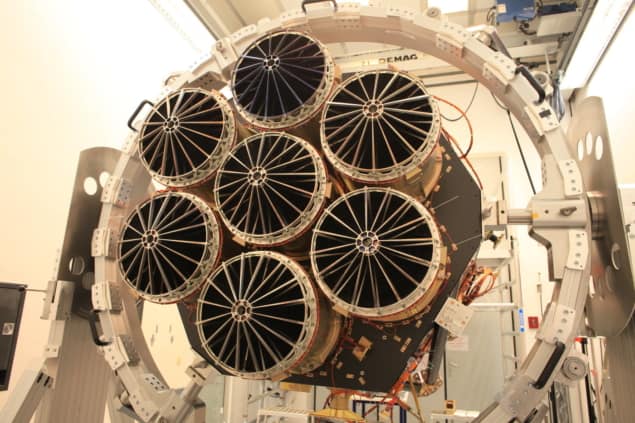
A long-awaited German–Russian telescope to survey the X-ray sky in unprecedented detail was successfully launched from Kazakhstan’s Baikonur Cosmodrome on 13 July. The Spectrum-Roentgen-Gamma (Spektr-RG) mission is designed to detect 100,000 galactic clusters allowing astrophysicists to constrain the properties of dark matter and dark energy, and hence test models of the expansion of the universe.
Its enormous sensitivity will allow us to constrain cosmological parameters
Esra Bulbul
Spektr-RG consists of two instruments, one of which is eROSITA – an X-ray survey telescope designed and built by Germany’s Max Planck Institute for Extraterrestrial Physics (MPE) in Garching, which will operate at 0.2–10 keV. “It will provide a map of the entire sky in the 2–10 keV band for the first time,” says Esra Bulbul from the Harvard-Smithsonian Center for Astrophysics, who will become chair of MPE’s eROSITA cluster and cosmology team in September.
Bulbul says that the mission is about 30 times more sensitive than ROSAT — the previous all-sky survey X-ray telescope — in the soft X-ray band at 0.2–2 keV. “Its enormous sensitivity in that band will allow us to detect galactic clusters and constrain cosmological parameters,” she adds. China launches X-ray telescope
Backing up eROSITA is ART-XC — a Russian-built telescope that can detect X-rays at 6–30 keV. This will allow the mission to detect supermassive black holes at galactic centres as well as study the “3.5 keV emission line” that could be produced by the decay of dark-matter particles. “The distribution of the dark-matter candidate line within our galaxy will allow us to test the origin of this signal,” says Bulbul, who adds that eROSITA will also aim to investigate the “physical processes at play in large-scale structures” as well as “nail down the evolution of metals in our universe”, which are all “unreachable with the current X-ray telescopes”.
Data taking
Spektr-RG’s immediate destination is Lagrangian point 2 – a gravitational-balance point over a million kilometres beyond the Moon’s orbit where it will be free from temperature variations. According to Peter Predehl from the MPE, who is the mission’s principal investigator, the telescope will take about 100 days to reach that point after which it will orbit around it. Once there, the telescope will set out on its first full-sky survey, which should take about six months. It will then repeat the process and continue to do so, improving the resolution each time. “The only constraint is to keep it there for at least seven years with minimum fuel consumption,” says Predehl.



